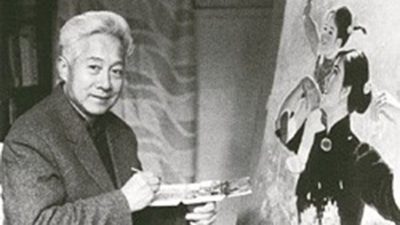Written by Cassie Lin
I came across a lot of names when cataloguing the poster collection, names of the artists, printed at the bottom of each poster, some appear more often than the others. So I began to wonder – who are they, what are their life stories, and their artistic pursuits behind these reproductive and strongly stereotypical propaganda posters, especially when they were living through war and social turbulence?
Jin XueChen and Li MuBai are 2 names often appeared on the posters. Together with another artist Jin MeiSheng, they were known as the “Three Pillars of Calendar Posters” in 1920s Shanghai. As one of the earliest commercial hubs in China, Shanghai breed a large number of companies and brands at that time, and calendar poster was the main advertising method. These calendar posters often feature images of women with gentle body curves in fashionable outfit, promoting mostly cigarettes and beverages.
Jin XueChen (Left) and Li MuBai (Right)
Coca Cola Calendar Poster from the 1920s
After joining the ZhiYing Studio in Shanghai in 1928, Li MuBai and Jin XueChen formed their partnership that lasted decades. The two created many commercial calendar posters together – Li would sketch the human figures, while Jin would paint the clothes and accompanying scenery. After 1949, the establishment of Communist China, the Li and Jin partnership shifted their products from serving a commercial purpose to a political one. Both of them joined the Chinese Artist Association, and contracted on a special basis by the Shanghai Poster Publishing House. In their later works, cigarette holding beauties were replaced by political figures and proletarian characters. In 1956, Li and Jin were requested by the publishing house to establish the Mubai Painting Studio to train young artists.
‘Mao Meets Model Labourers’ by Li MuBai and Jin XueChen, 1964
‘The News Came Suddenly that She had been a heroin’ by Li MuBai and Jin XueChen, 1978
Ha QiongWen is another name largely appears in the poster collection. Unlike the former calendar poster masters Li and Jin, Ha represented another division of those propaganda poster artists. He studied in the Fine Art Department of Chong Qing Central University, joined the People’s Liberation Army after graduating in 1949, and worked for the Army’s Cultural Department in Beijing. Ha was later transferred to the Shanghai People’s Fine Art Publishing House in 19955, where he became one of the most prolific poster designers at that time.
Ha QiongWen
Our collection holds one of Ha QiongWen’s most controversial poster ‘Long Live Chairman Mao’. In 1959, the publishing house assigned a task to Ha for creating a poster to celebrate the 10th anniversary of establishing Communist China. Ha didn’t follow the stereotypical style of propaganda poster and painted political figure and a praised crowd, instead, he created an image of a mother and her daughter, immersed in the ocean of pink flowers and gazing upon a Huabiao (a ceremonial column used in traditional Chinese architecture) in Tian’an Men Square afar. Ha’s metaphoric portrayal in this poster ‘Long Live Chairman Mao’ caused him a lot of troubles during the socio-political movement – the Cultural Revolution in the 60s and 70s. He was accused of depicting a woman wearing ‘bourgeois’ outfit, and not showing an image of Chairman Mao explicitly. Ha was attacked as the “Top Celebrities of the Literature and Art Black Line”, and often dragged out as an object for public abuse during each “criticism session”. Despite the humiliated mistreatment and a suicide attempt during the period of Cultural Revolution, Ha QiongWen remained active as a poster designer until his retirement in 1992.
‘Long Live Chaiman Mao’ by Ha QingWen, 1959
The era of propaganda poster is disappearing, along with these great artists created them. It is an absolute shame that the Chinese propaganda posters are more emphasised by their political value, rather than its creativity in visual arts. I guess it’s the inevitability of history, but it’s worth remembering their names, no matter how easily to be neglected, when you are checking out the posters, those names are printed at the bottom of each piece.
消失的艺术家
一开始接手中国宣传画收藏工作的时候,总是会留意到宣传画下方的艺术家署名。有一些名字,总是出现得要多一些,长期整理下来,也就渐渐记住了。于是不禁要去想,这些创作出被大量复制的政治宣传画的艺术家们,他们的生平,他们的艺术理想,他们在经历着社会变迁的时候,是怀着怎样的心思下笔的?
李慕白,金雪尘,这两位艺术家的名字,时常会出现在同一张宣传画上。将时光追溯回1920年代的上海,他们二位,与另外一名艺术家金梅生先生,在当时被誉为“月份牌三巨擘”。“月份牌”广告画,原型最初由西方外商引进,后来与东方本土文化相互影响,形成了中国半殖民地半封建时期的一种特有的商品广告文化。“月份牌”广告画大多以形象秀丽的上海摩登女性为主角,同时借鉴西洋画的技法,用以推广香烟、饮料等舶来产品。20年代末,李慕白、金雪尘先生一同加入上海“稚英画室”,负责月份牌和其他设计业务。作品通常由李慕白起稿、设计人物造型,金雪尘负责服饰、背景和颜色搭配,由他们所创作的“月份牌”广告画,很快出版发行遍及全国,甚至远销海外。(《图像与商业文化》- 吴咏梅,李培德)
1949年,新中国成立以后,李慕白与金雪尘先生顺应时代需要,开始创作共产主义宣传画。他们加入了中国美术家协会,并被上海人民美术出版社受聘为特约年画作者。曾经他们笔下那些身着旗袍、手持香烟或酒杯的俏丽女士,被伟岸的革命领袖和无产阶级革命者的形象替代了。1956年,李慕白受命在出版社创办‘慕白画社’,培养青年画家。80年代后期,金雪尘宣布封笔,从1925年的上海“稚英画室”,到1980年代的上海人民美术出版社,六十余年里,金先生见证了中国早期视觉艺术在商业与政治之间的发展与变迁。(《关于月份牌的往事》-张显辉)
哈琼文,是另外一个时常出现的艺术家名字。与李慕白、金雪尘这些“月份牌”设计名家不同,哈先生代表了宣传画艺术家群体里的另一股力量。哈琼文是科班出身,曾就读于重庆中央大学艺术系绘画专业西画科,毕业后参军,并于1955年转业至上海人民美术出版社,长年从事宣传画创作。
我们的宣传画收藏里,有一副哈先生最富盛名,曾经也最受争议的作品《毛主席万岁》。1959年,上海人民美术出版社委托哈琼文为建国十周年大庆创作一幅重点题材宣传画。创作时,哈先生并未采用当时宣传画所流行的领袖、横幅、鲜花、人民欢庆等元素,画中只有一对母女,沉浸在玫红色的花海之中,遥望着远处若隐若现的华表-天安门与毛主席的象征。这一幅宣传画出版后受到极大欢迎,一时洛阳纸贵,五年内重版了20多次,累计印刷量高达250万张。它诞生于政治气氛最为热烈的时期,却也在那个特殊的年代里令哈琼文遭受了不少责难。文革期间,由于《毛主席万岁》并未出现具体的领袖形象,且画中的妇女穿着旗袍,戴着胸针,被造反派斥责为“资产阶级的少奶奶”,让哈先生挨了多次批斗。所幸他并未因此停止艺术创作,并终生将其视为美好而充满意义的过程。(《哈琼文与他的“毛主席万岁”》-李畋畋)
中国宣传画的时代已经渐渐远去了,连同曾经创作它的艺术家们。在当代学者和评论家的眼中,中国宣传画的政治意义始终大于其艺术价值,这不能不说是一种遗憾。也许这就是历史的必然性及其无奈之处,但也不妨碍我们在翻阅宣传画收藏的藏品时,花一点时间,记住每一幅画底下印着的各个艺术家的名字。
Cassie Lin is a doctoral student at the University of Westminster. She previously worked as an archive assistant at the University of Westminster’s Chinese Poster Collection, now renamed the China Visual Arts Project Archive.
- TV Drama Discourse on Stay-at-home Fathers in China: Super Dad & Super Kids - January 28, 2022
- Freud and China - January 20, 2022
- “Cultural China 2020″—A Different Take on China - January 7, 2022






